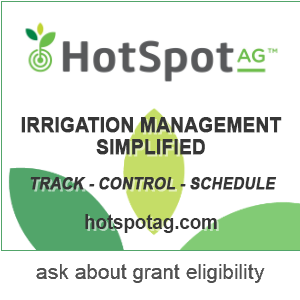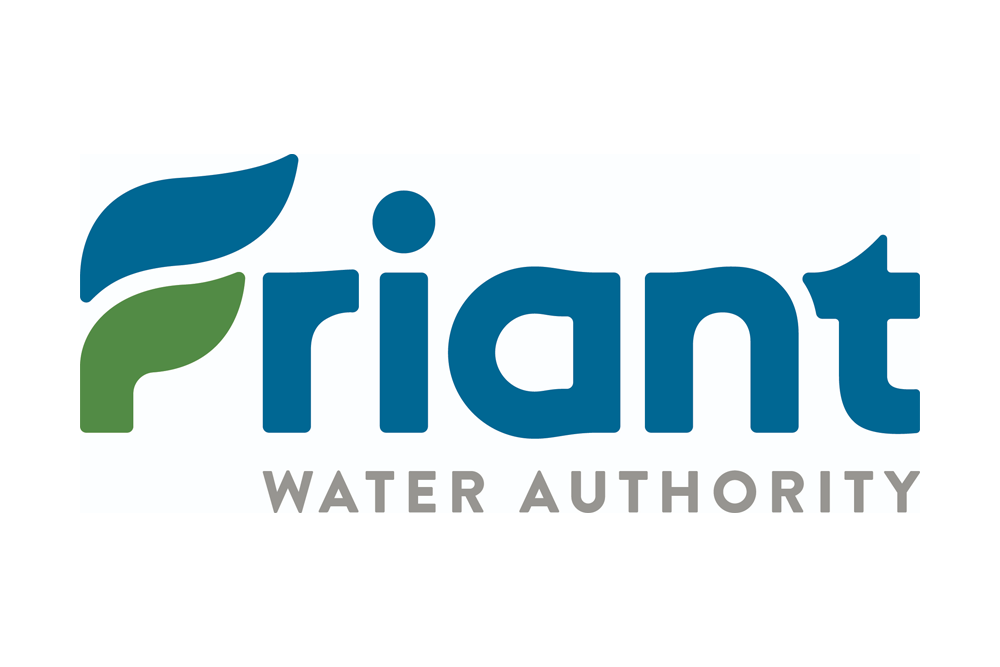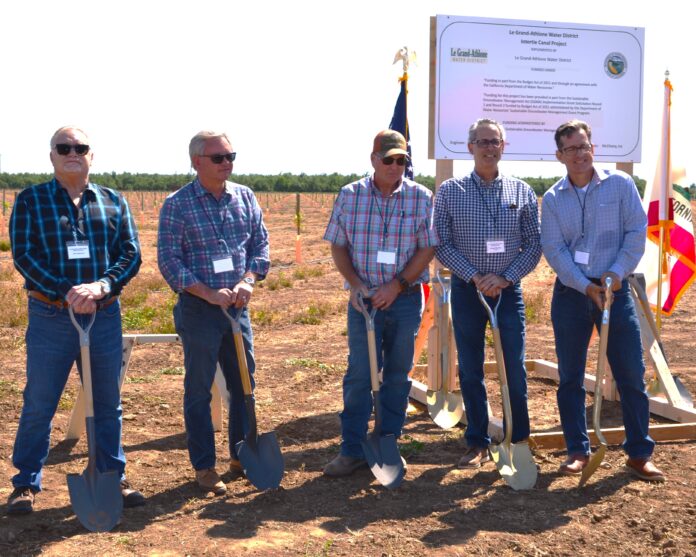From left: LGAWD Directors Jim Kopshever, Kevin Herman, Phil Janzen and Alfredo Martinez, board president, with GM Brad Samuelson. Photo Joel Hastings
By Joel Hastings
A ceremonial groundbreaking was held May 13, 2024, for a $21 million surface water infrastructure project spearheaded by the Le Grand – Athlone Water District (LGAWD), which encompasses over 26,000 acres of irrigated farmland north and east of Chowchilla. Called the Intertie Canal Project, it will construct a new canal within LGAWD connecting the Merced Irrigation District’s existing water delivery system south to the Chowchilla River. The project is being funded primarily from the Department of Water Resources SGMA grant program.
The project is being funded primarily from the Department of Water Resources SGMA grant program.
The Ceremony
LGAWD Board President Alfredo Martinez welcomed more than 30 people to the event at 10 a.m. The site was along Le Grand Road, just west of the Ipsen Road intersection where new canal construction will actually occur. He led the Pledge of Allegiance, then introduced Joe Ballas on the staff of Assembly Member Esmeralda Soria, who represents this community in the legislature and is chair of the Assembly Ag Committee. Next was Diana Westmoreland of the staff of State Senator Anna Caballero. Both complimented the collaboration of the two water districts and expressed their support for this innovative project to benefit agriculture in the area.
Martinez then introduced Christopher Olvera, DWR grant program manager in Fresno who has coordinated the funding.
Asking for a moment of silence, Martinez recognized the late Kole Upton, a former leader of LGAWD and well known in water circles throughout the Valley.
Coming next to the podium was Brad Robson, local grower and packer of organic pistachios, who farms in the LGAWD and has long advocated a project of this type. He called Le Grand a great little farming community that is really an agricultural powerhouse. He credited Upton with involving him in the organization.
pistachios, who farms in the LGAWD and has long advocated a project of this type. He called Le Grand a great little farming community that is really an agricultural powerhouse. He credited Upton with involving him in the organization.
He recalled inviting Dr. Charles Burt, longtime irrigation professor at Cal Poly, to come to the District to recommend how additional surface water could be obtained. He said LGA “doesn’t own a lake,” but with the completion of this Intertie project, 30,000 acres of farmland will be sustainable.
Brad Samuelson came to the podium to provide more detail about the project. He’s the LGAWD contract general manager whose firm, Water and Land Solutions in Los Banos, provides services to a number of water organizations and landowners. He said the project began with a feasibility study followed by a Prop 218 election with landowners agreeing to tax themselves up to $84 / acre as a “leap of faith” since no new water contract was in place.
began with a feasibility study followed by a Prop 218 election with landowners agreeing to tax themselves up to $84 / acre as a “leap of faith” since no new water contract was in place.
Following grant applications and extensive permitting efforts, the project now will be completed in three phases… two and a half miles of new canal, upgrades to the existing MID infrastructure and finally taking water through the southern part of the District all the way to the Chowchilla River and Chowchilla Water District area. Samuelson had a long list of those to thank, including the LGAWD directors – Martinez, Kevin Herman, Jim Kopshever and Phil Janzen along with Bob Giampaoli who was not present due to illness.
He also read a statement from Paul Gosselin, DWR’s Deputy Director of Sustainable Water Management:
“Today’s project marks a step forward for California’s water security. By working with our partners, we’re investing in a groundbreaking project that will reduce dependence on groundwater pumping and improve flood protection for our communities by recharging vital supplies through innovative stormwater capture. This is a win-win for our environment, our communities, and future generations.”
groundwater pumping and improve flood protection for our communities by recharging vital supplies through innovative stormwater capture. This is a win-win for our environment, our communities, and future generations.”
With that, the decks were cleared, the shovels taken up and the first dirt was turned by a growing group starting with the directors but eventually including engineers, officials and staff along with local growers and business leaders. The session concluded about 10:40 a.m. and lunch was to be served in nearby Le Grand.
The Intertie Project
According to a news release distributed by the District, when completed the Intertie and recharge project benefits will include flood protection for the communities of Planada, Plainsburg, Le Grand and El Nido; increased water supply reliability for the region, including an improved community water system for Le Grand; and contributions to groundwater recharge and land subsidence mitigation.
“The Intertie Project will construct the infrastructure needed to convey surface water supplies to LGAWD for the benefit of the District’s farmland in the critically overdrafted Merced Subbasin,” Samuels says in the release.
“When in operation, the Project will decrease flood pressure on MID, decrease reliance on groundwater pumping, energy consumption and subsidence in the southern Merced Subbasin, thereby creating water resiliency for the disadvantaged communities of this region.”
The first phase will be two and a half miles of new canal with a capacity of 125 cubic feet per second along a structure 12 feet wide at the bottom near the northern part of Mariposa Creek. The canal will pass through rural ag lands and construct 84-inch diameter siphon pipelines under Mariposa Creek, Le Grant Road, Ipsen Avenue, Deadman Creek and Dutchman Creek. There will also be discharge pipelines into those creeks, integral to convey irrigation and floodwater throughout LGAWD.
The second phase will be upgrades to the infrastructure of MID with nearly ten miles of canal enlargement for the existing MID-Le Grand Canal and MID Booster 3 Lateral Canal to 125 cfs.
Phase 3 will connect to the south end of the Phase 1 canal, constructing a new 125 cfs booster pump station south of Dutchman Creek and approximately two miles of pipeline and canal infrastructure to convey water to the south end of the District, siphoning beneath the Santa Fe Railroad and Santa Fe Avenue.
When the project is completed, the release continues, the Intertie Canal will have the capacity to divert and convey an additional 125 cfs of surface water, including flood waters when present. This will allow for recharge of surplus stormwater of approximately 6,570 AF per year of in-lieu groundwater recharge for more than 40,000 acres of farmland in the area. The access to this surface water, in place of typical groundwater pumping will also benefit the environment by saving approximately 8.9 million kilowatt hours / year of energy consumption and protect state and local infrastructure from land subsidence. The ability to move the surplus stormwater will benefit the area’s disadvantage communities as well.
surplus stormwater of approximately 6,570 AF per year of in-lieu groundwater recharge for more than 40,000 acres of farmland in the area. The access to this surface water, in place of typical groundwater pumping will also benefit the environment by saving approximately 8.9 million kilowatt hours / year of energy consumption and protect state and local infrastructure from land subsidence. The ability to move the surplus stormwater will benefit the area’s disadvantage communities as well.
The Le Grand – Athlone Water District was established in 1964 to primarily serve agricultural production within the District boundary.
DISCLAIMER OF RESPONSIBILITY; Waterwrights.net strives to provide its clients with the most complete, up-to-date, and accurate information available. Nevertheless, Waterwrights.net does not serve as a guarantor of the accuracy or completeness of the information provided, and specifically disclaims any and all responsibility for information that is not accurate, up-to-date, or complete. Waterwrights.net’s clients therefore rely on the accuracy, completeness and timeliness of information from Waterwrights.net entirely at their own risk. The opinions expressed in this report are those of the author and do not represent any advertisers or third parties.
ALL RIGHTS RESERVED. Copyright 2024 by WaterWrights.net


































